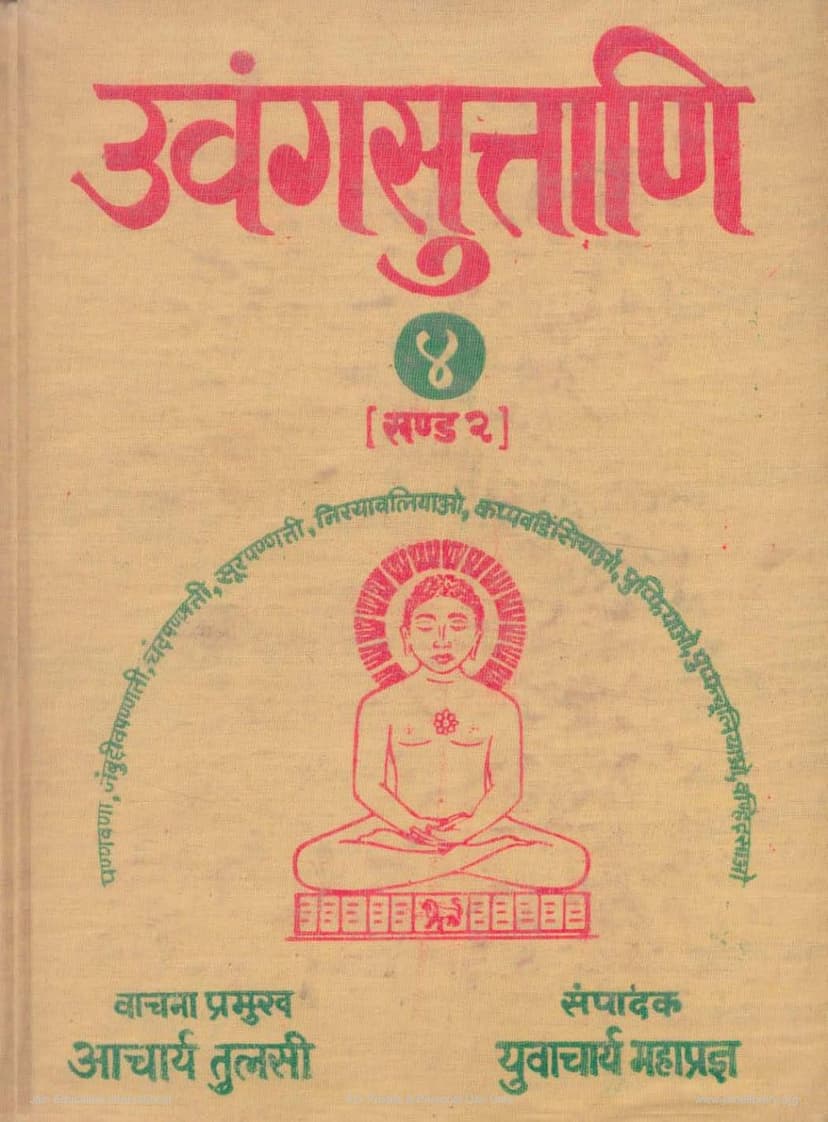Agam 22 Upang 11 Pushpachulika Sutra Puffachuliyao Terapanth
Added to library: September 1, 2025

Summary
Here's a comprehensive summary of the Jain text "Pushpachulika" (Agam 22, Upang 11), based on the provided information:
Book Title: Agam 22 Upang 11 Pushpachulika (Sutra Puffachuliyao) Author(s): Acharya Tulsi (Vachana Pramukha), Acharya Mahapragna (Editor) Publisher: Jain Vishva Bharati, Ladnun (Rajasthan) Catalog Link: https://jainqq.org/explore/003578/1 Publication Year: Vikram Samvat 2045 (1989 AD) Pages: 1170
Overall Context:
This text is part of a larger, monumental project by Jain Vishva Bharati to critically edit and publish all Jain Āgamas. "Pushpachulika" is the 11th Upanga and the 22nd Āgama in the series being published. This specific volume, "UVANGA SUTTĀNI (KHAN D 2)," contains nine Upanga Āgamas in total. "Pushpachulika" is one of these nine. The project emphasizes the original text with variant readings, word indices, and scholarly commentary.
Key Āgamas Included in this Volume (Part II):
- Panṇavaṇā (Prajñāpanā): Discusses sentient (jiva) and insentient (ajiva) substances extensively. It's called Prajñāpanā as its first section is named so, and it expounds reality through question-answer. It's considered an essence or "niḥsyanda" of Drishtivada (the 12th Anga).
- Jambuddivapaņņatti (Jambūdvīpa Prajñapti): Primarily deals with Jambūdvīpa, encompassing topics like Lord Rishabha, Kūlakaras, Bharata Chakravarti, the cycle of time, and the solar system. It's noted for its detailed and vivid descriptions of Bharata Chakravarti's fourteen jewels and nine treasures, as well as a thrilling account of the sixth "ara" of the descending cycle, which is likened to the horrors of an atomic war.
- Candapannatti (Chandra Prajñapti): Primarily deals with the moon.
- Sūrapannatti (Sūrya Prajñapti): Primarily deals with the sun.
- Nirayāvaliyāo (Nirayāvalikā): Focuses on the subject of good and bad conduct, karma, and their consequences. The first section describes the battle between Chetaka and Konika, the second describes the salvation of Shrenika's ten grandsons, the third discusses the observance and violation of self-restraint and right faith, the fourth describes the ten disciples of Parshvanatha, and the fifth narrates the conduct-observance of the twelve princes of the Vrishni dynasty and their rebirth in "Sarvarthasiddhi."
- Kappadisiyaṁo (Kalpavadamsikāyo):
- Pufïhiyāo (Pushpiya):
- Pufïhcūliyāo (Pushpachūlikāyo): This is the specific Upanga mentioned in the title. The provided text includes the beginning of its first chapter (Adhyayana).
- Vanhidasāo (Vṛṣṇidaśā):
Key Themes and Editorial Approach:
- Comprehensive Āgama Publication: This volume is a significant milestone, marking the completion of the publication of all 32 Āgamas in their original text form, including variant readings and indices.
- Critical Editing: The project involved extensive research, consultation of multiple manuscripts, and critical analysis of commentaries. The introduction highlights the challenges of editing ancient texts due to language and conceptual shifts over millennia.
- Leadership and Collaboration: The project was guided by Ācārya Tulsi as the "Vācanā-pramukha" (chief guide for recitation/teaching) and Yuvācārya Mahapragna as the Editor. It involved the dedicated work of numerous monks and nuns.
- Spiritual Significance: The Āgamas are presented not just as historical or literary documents but as profound sources of "tattva-vidya" (science of reality) and "tattvajñāna" (knowledge of reality), guiding towards truth and the path of non-violence.
- Dedication: The preface by Acharya Tulsi expresses deep satisfaction and inner fulfillment in seeing this lifelong vision of Āgama editing come to fruition through the collective efforts of the spiritual community.
- Contextualization: The text includes detailed introductions to each Āgama, explaining its name, subject matter, author, and compilation period, often connecting it to other Āgamas or historical Jain figures.
- Focus on "Pushpachulika": The beginning of the first chapter of Pushpachulika is provided, starting with a dialogue between Lord Mahavira and his disciple Jambū, discussing the number of chapters in Pushpachulika and then delving into a narrative about a woman named Bhuta and her spiritual journey, her decision to renounce worldly life, and her eventual rebirth as a celestial being.
Significance of the Work:
This publication is considered a groundbreaking achievement in the history of Āgama scholarship, making 32 Āgamas available in a critical edition for the first time. It represents a significant contribution to Jainology and the preservation of Jain canonical literature. The work was supported by various trusts and individuals, highlighting a broad commitment to this spiritual and academic endeavor.